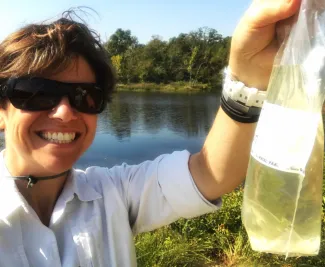
Priscilla Crawford, conservation biologist for the Oklahoma Biological Survey, is on the hunt for invasive plants. So far, she’s visited more than 100 Oklahoma lakes to see if invasive aquatic plants like hydrilla, yellow iris, and parrot’s feather have reached specific waterbodies in our state.
“Fortunately, we haven’t found many significant infestations of our seven targeted plants that weren’t already known.” Outside of the known infestations of invasive plants, Crawford’s team has found Eurasian watermilfoil in high densities around public access areas at Spavinaw Lake. The team also found a previously unreported infestation of zebra mussels, another aquatic nuisance species, at Pawnee Lake.
“Invasive plants have the potential to become ecological and economic problems for our state. Some of these plants can take over side channels or backwaters of reservoirs and outcompete native plants, which may affect fish and wildlife populations,” Crawford said. “They can also clog drainage ditches and cause engine problems for boats.”
Lake-goers can help prevent the spread of these problematic plants in a few simple ways. Stop Aquatic Hitchhikers by remembering to “clean, drain, and dry” before you leave the water access point.
- Clean: Pressure wash any boat, kayak, canoe or other vessel with hot water (140°F) and remove any plant fragments, mud, and aquatic organisms that are visible.
- Drain: Drain all water from your boat, motor, bilge, live wells, hauling tanks, coolers and ballast.
- Dry: If pressure wash is not available, allow the boat, trailer, and equipment to dry thoroughly for at least five days before using in a new water body. If equipment cannot be thoroughly dried, treat with a 10% bleach solution to decontaminate.
“Something as small as washing your boat down, or washing your boots in hot water, can help keep these plants from spreading from waterbody to waterbody. You can also help biologists by reporting invasive species in your area.”
For more information about Oklahoma’s Aquatic Nuisance Species Program and the species that are impacting our state, visit wildlifedepartment.com.
Surveys and future mapping efforts of the seven target plants is being funded in part by ODWC’s State Wildlife Grants Program Grant F15AF01321.